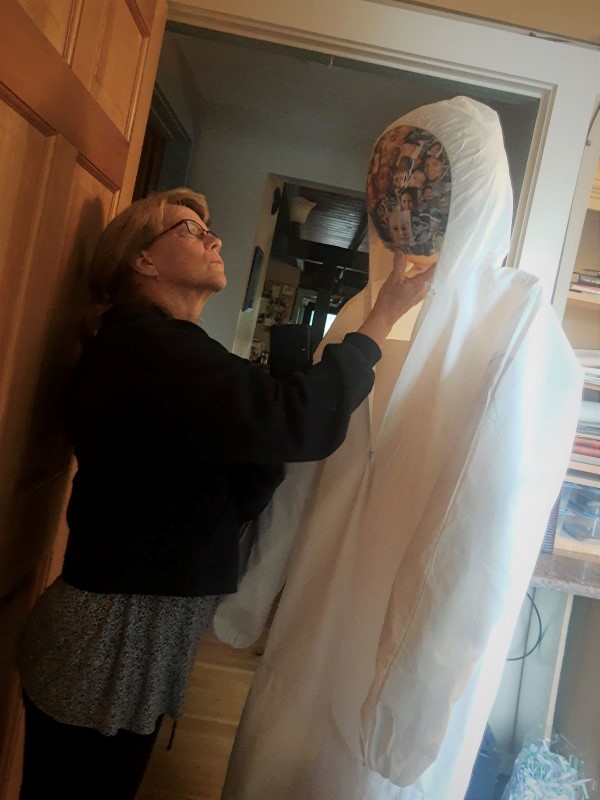
I’m out of my league. I don’t know what I’m doing. I’ve never done this before. I could fail.
My inner critic lobs these reminders to me as I carry on with the building of my improv suit. There’s an element of truth to each of the warnings, but not enough to stop me. The chatter is not unlike the tinnitus I’ve developed; when my focus is elsewhere it doesn’t bother me.
The suit is an exploration. This nonverbal melding of heart and hands will help me to flesh out concepts and feelings and, eventually, to find words I’m looking for. It’s a way of digging in.
All the work I want do right now is based in celebrating the human spirit. That realization came to me in a conversation about framing up my vocation. Within twenty-four hours of verbalizing that, I began my What Matters photo album, and was given an opportunity to express through making; Jean Cherouny asked me to take part in a project called Improv Suits.
Jean’s On This List
Some of the coolest people you could ever wish to know (Jean included) are listed on this roster of teaching artists. When I was associated with the Arts Council, I became familiar with and began to admire the work of these thoughtful, energetic, creatives. I often referred to them as heroes.
Eric Booth is a renowned arts learning consultant who speaks well about the magic of that profession. He is adept in describing the ways in which creative activities change us. Reading him helps me understand how saying “yes” to an art project can better me as a life coach. Consider this powerful list made by Mr. Booth in a larger posting:

THE HABITS OF MIND OF CREATIVE ENGAGEMENT
These are the key processes, actions, and attitudes activated when we invest ourselves in the flow of creating. These can be focused on and developed as habits of mind.
1 • Generating multiple ideas and solutions.
2 • Sustaining an inner atmosphere of exploration.
3 • Using one’s own voice.
4 • Trusting one’s own judgments.
5 • Formulating good questions and problems.
6 • Improvising.
7 • Finding humor.
8 • Crafting.
9 • Making choices based on a variety of criteria.
10 • Inquiring skillfully.
11 • Persisting.
12 • Self-assessing.
13 • Reflecting metacognitively.
14 • Thinking analogically.
15 • Willingly suspending disbelief.
16 • Observing intentionally.
17 • Going back and forth between parts and wholes.
18 • Trying on multiple points of view.
19 • Working with others.
20• Tapping and following intrinsic motivation.
Yes please. I would like to do that. I would like to be that. What habit on this list that would not serve me well in being a great coach, facilitator, colleague, friend, partner, or world citizen?
About My Piece

Diverge, Converge
There’s a concept based in design thinking used often in working with humans and solving problems. In most basic terms I’ll refer to it as diverge (create choices) | converge (make choices). It looks like this .

But difficult problems absolutely demand spending time and energy in the pulled-apartness rather than rushing to converge. That vertical dotted line in the first graphic must become something else, something more horizontal and spread out. The process begins to look more like this.
And it is uncomfortable for us to linger in the diverged and uncovered.
Facing Covid—and myriad other pressing world issues—I wonder when is it important to move ahead and when is it important to pull back? When to diverge and when to converge? How, in using phrases like “return to normal” and “get back to the way things were,” are we pushing away discomfort at the cost of discovering something new? When does rushing to a solution not serve us? When does it? How might we discover the answers we need in response to all the wicked problems confronting us?

I often follow this same path in a workshop, retreat, or a coaching session.
Individually and collectively, we need to ramble around sometimes in that wild and messy, scary, comforting, gorgeous, shining, surprising, wonderful force that lives in each of us. We benefit from exploring the space which can remind us how to keep going, what we have to offer, and . . .
What Not to Heed
My inner critic visits again. It has switched gears and is showing me everything it doesn’t like about my suit. My technical chops are absolutely those of the amateur (which I am). The concept might fall flat. The result could be misinterpreted.
But, I can’t fail at this. My improv suit is built. You could say I’ve got it made.
Susan McDowell is a coach, facilitator, and creative based in Central Vermont.
Read more of her blog here.
Susan. This liminal Improve Suit that you have made and shared is BEAUTIFUL! Liminal space is: “Our ambiguity or disorientation that occurs in the middle stage of a rite of passage, when participants no longer hold their pre-ritual status but have not yet begun the transition to the status they will hold when the rite is complete.” When I think of the many humans who are enduring the days on days in the years ahead, I want them to read about your making of your Improve Suit and join the movement!
I am thinking about the in between space which is uncomfortable in my art. Although I create with intention each time I make, I am not aware of what I am creating. I also rollerblade painted on my Improv Suit and people can see it on Instagram at Jean_Cherouny. Here is what Joseph Boys said about his felted suits that he made as a collection in Germany in 1970: ‘I don’t give a damn. You can nail the suit to the wall. You can also hang it on a hanger, ad libitum! But you can also wear it or throw it into a chest’ . You did what you did and it worked! Then there was Nick Cave, an African American Artist used “Soundsuits” to break barriers. His suits had a result in order to,” serve as an alien second skin that obscures race, gender, and class, allowing viewers to look without bias towards the wearer’s identity. What does Improv Suits allow now? It allows community as a collective think tank. Now in fashion the white hazmat suits give participants a while slate to create your own. “The White Shirt, According To You. Every “ANNE FONTAINE” white shirt is a blank canvas to build the foundation of elegant and timeless style.” Anne Fontaine as a designer might do well to consult you! You remade fashion to be who you are now! I just gave you a blank slate of solidarity and you made it so much more for yourself and others. Thank you for your blog post.
I love how you used the tool of your writing craft to expand your work with your researched ideas on Eric Booth. Ideas are an open source and a way to access something between thinking and doing. It is so different from trying to be noticed for an idea because it looks like something we already know. It is a progression to follow through on and expand on as a collective. Now that you have become a trailblazing “Maker” I wish you so much joy in helping other emerging humans who are awakening now.
I love the way you expanded this even more. Thanks, Jean!
Comments are closed.